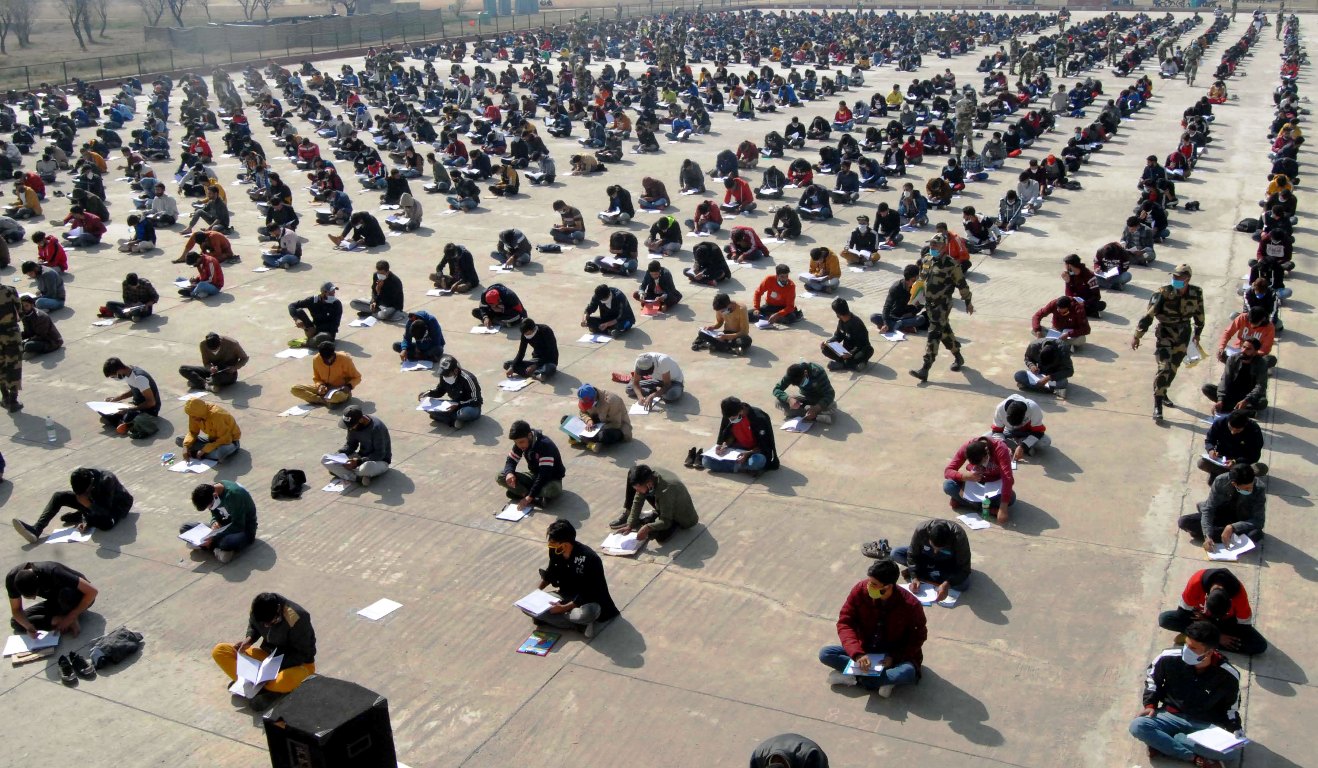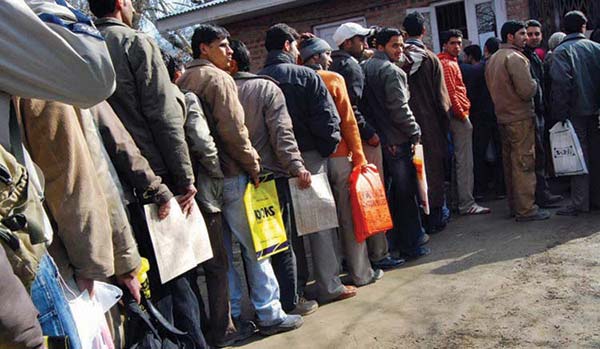For managing joblessness in one of the least poor territories in India, Syed Suhail Yaqoob argues for a quick rethink in curriculum and innovative policy interventions at the earliest

An interesting situation has emerged in Jammu and Kashmir. Centre for Monitoring Indian Economy (CMIE) figures put the unemployment in Jammu and Kashmir at 16.2 per cent, much higher unemployment than the national average that stands at 6.7 per cent in 2016. In 2020, the unemployment rate has gone up to 17.8 per cent.
The greatest concern is that youth unemployment stands at around 14 per cent in Jammu and Kashmir. The PLFS (Periodic Labour Force Survey) report argues that there is also huge chronic underemployment across the erstwhile state. If the status under ‘current daily’ and ‘current weekly’ will be taken into consideration, the unemployment rate will be much higher than the UPS.
The GSDP
In Jammu and Kashmir, agriculture does not provide employment throughout the year but has some job peaks, especially during harvesting. The recent report by CMIE has argued that the unemployment level has fallen to single digits. This conclusion is debated given that Jammu and Kashmir has gone through some worst phases since 2016. Unemployment is at such an extreme level despite over six per cent growth in Gross State Domestic Product (GSDP).
Over the years, there has been an increase in the share as well as the growth of the service sector in the GSDP. However, this sector has failed to generate employment for youth as per the surge it shows. Although the service sector doesn’t contribute that much to employment, it is the agriculture sector that has more than 50 per cent share in total employment despite that it contributes less than 15 per cent to our GSDP.

Shrinking Landholding
It is pertinent to mention that Jammu and Kashmir is highly reliant on agriculture for jobs but these jobs are only available for a few months, especially around harvesting. There is a serious crisis going on in agriculture and Jammu and Kashmir will also see a dip in job creation as there is an increase in marginal holdings which now consist of more than 90 per cent of overall landholdings.
Further training guns in the horticulture industry will not serve the goals of job creation, however, income generation can be achieved through community-driven agriculture and moving to new cash crops from within the fruits basket. In recent weeks, reports appearing in the media suggest the prices of agricultural production especially apples have crashed. The present global economic crisis owing to the Covid-19 pandemic has only made the unemployment situation much worse.
Fragile Tourism
Some analysis suggests that the solution to the problem of unemployment lies in sectors like the industrial and tourism sector. No doubt that Kashmir is known for its tourism potential, however, the fragile activity has remained dependant on the political situation in the region.
A crisis in the region leads to a direct impact on tourism. It is a phenomenon that Kashmir was observed since 1990. There was a sharp fall in the arrivals in 2008, 2010, 2016 and now during the pandemic. Until the region remains at peace, it is impossible to create a sustainable livelihood from the tourism sector. Good relations between Pakistan and India will create a conducive atmosphere for sustainable livelihood from the tourism sector. Peace in the region will facilitate the opening of roads, which are bound to generate enough employment.

The Industrial Sector
The same is the case with the industrial sector. The region can boost only those sectors on which we have an edge like shawl industry, carpet making and paper machie. No doubt Kashmir also produces a lot of important inputs for industrial purposes. What is lacking is the processing of those inputs.
For instance, we produce one of the finest apples in the world, which we selling to other states rather than processing here. The state could have created thousands of jobs through the simple installation of food processing units. Unfortunately, the erstwhile state has become the producer of raw materials rather than finished goods.
Few of us have an idea that the state is rich in minerals like copper are lead, zinc, bauxite, chromium, gold, arsenic, kaolinite, bios-pore, ochre, coal, lignite, slate, marble, sapphire, rubellite, quartz and serpentine. The exploitation of these resources is crucial to generate employment for thousands of people.
Road Reopening
Given that Jammu and Kashmir has a unique geographical position, it needs both investment and political will between India and Pakistan. The location of the state closer to the central Asian countries would provide a boost to its economy and make it a financial hub.
Economic history has shown that the border-states have always become the hub of economic activity. The history of Kashmir has shown that the state had huge economic relations with the central Asian countries spanning many centuries. In 2008 the government of Jammu and Kashmir opened two important routes which include Uri-Muzaffarabad and Poonch-Rawalakote. The new routes may include Jammu-Sialkot, Chhamb-Jourian-Mirpur, Gurez-Astor-Gilgit and Jhanger-Mirpur. Simple economics suggest that connectivity is essential for the growth of employment in every economy. If the opening of the trade routes takes place, there will be a boom in job creation in the state.
Since it began the experts estimated that more than Rs 6000 crore worth of trade was transacted through the cross-LoC points and a total of 1.6 lakh job days were created. In 2008-09, the traded goods were only worth Rs 3 crore (Pakistani) and Rs 2 crore (Indian). The trade jumped to Rs 441 crore (Pakistani) and Rs 454 crore (Indian) respectively in 2018-19.
BRIEF Study
According to a study by the Bureau of Research on Industry and Economic Fundamentals (BRIEF), about 662 traders from Jammu and Kashmir are registered to trade at both points at Uri and Poonch, of whom 110 traded actively. The traders had said that with uncertainty over the reopening of the trade, their livelihoods will be in jeopardy, along with those loaders, transporters, retailers who were part of their trade, as well as their families, totalling around 40 thousand people.
The Jammu and Kashmir government had estimated that there was a recorded import of Rs 2500 crore of Indian currency up to (the end) of March 2016. A kind of peace agreement between the two states can help to boost the growth rate.
Reform Education

Reform in the education sector is especially needed to ensure that the youth get decent jobs. It is everybody’s knowledge that the sector is beset with problems of incompetence, lethargy and bookish knowledge, which is less valuable in the current digital age. A cursory look at higher education will reveal that these institutions lack imparting skilled courses to students. Jammu and Kashmir still rely on outdated theoretical knowledge with no regard to either combination of subjects or skill courses.
Now when skill courses are introduced in the college curriculum, there is also corruption and lack of planning in introducing these courses. Unfortunately, skill courses provided are just the other theoretical subjects. Some colleges have made an effort to introduce skill courses through incubation and learning centres, however, there is still a long way ahead.
At the same time, the education sector is beset with redundancy and corruption as a long term plan is completely missing. History suggests that economic growth and employment goes in tune with quality education especially skill development. It has become a matter of most importance to revive education especially college education to boost chances of employment in the state.

The recent data on unemployment must generate a serious concern at every level of our society. The report shows that the state is fairing worst in the unemployment scenario, especially among youth. For the employment generation, few necessary steps must be taken. It needs a serious political will. Opening of trade routes and communication is sure enough to generate much employment coupled with reviving education and investment in new tourist places. It is important for researchers to note why in Jammu and Kashmir the poverty is so low despite high levels of unemployment. Few have dwelled on the subject. However at present to provide opportunities for employment skill courses with long term planning must be encouraged at the earliest.
(The author is PhD in economics from Aligarh Muslim University. The opinions expressed in this write-up are those of the author’s and do not purport to reflect the views of Kashmir Life.)














